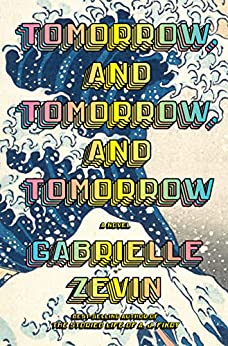 I accidentally read Tomorrow and Tomorrow and Tomorrow, by Gabrielle Zevin, over a game convention weekend, while I spent the rest of my time demoing my games, playtesting a new game, and talking about game design. We also did a panel where my husband/co-creator explained his workflow as a wind-up robot, that gets keeps going and going, and I had to say that I have 10,000 ideas in all directions, but not every idea is a great game. Then I came home and read this story about gamemaking creativity and relationships.
I accidentally read Tomorrow and Tomorrow and Tomorrow, by Gabrielle Zevin, over a game convention weekend, while I spent the rest of my time demoing my games, playtesting a new game, and talking about game design. We also did a panel where my husband/co-creator explained his workflow as a wind-up robot, that gets keeps going and going, and I had to say that I have 10,000 ideas in all directions, but not every idea is a great game. Then I came home and read this story about gamemaking creativity and relationships.
In Tomorrow and Tomorrow and Tomorrow, childhood friends (and sometimes frenemies) Sadie Green and Sam Masur agree to spend a college summer making a game together. With Sam’s college roommate, Marx, as their producer, their first game, Ichigo, becomes a massive hit. This is the goal for all of us making indie games, but the novel is actually about long-term creative collaboration, not about the magic of a success.
Their game creativity is a special kind of work, there’s a lot of time between Cool Idea and Finished Game, and that’s when we see our characters grow and change, fall in and out of love, struggle to understand and be understood. I particularly loved how Marx, the producer, was described as doing all the invisible work that let Sam and Sadie do their work better. There’s a lot about inspiration and accidental inspiration, with game journalists making connections the developers didn’t see. The book has a couple experimental sections, and they’re not all quite as engaging as the main narrative, but I think in any book about game dev, a chapter set inside the game world is basically obligatory.
Tomorrow and Tomorrow and Tomorrow is not just about games, it’s also a story about disability and trauma and overcoming the past. Mazer’s injury, and the way he feels about his body play a major role in his personality. (It’s not exactly pleasant to read about his injury and amputation, but it’s not too gross, either.) We can see him developing and changing over the years. Overall, I think seeing our characters develop over time was one of my favorite parts.
You needn’t know a lot about games to follow the story, but some gamer moments resonated for me, and maybe they will for other gamemakers, too. Sadie starts out making Solution, which is not exactly Train, but has a similar feeling (Weirdly, this same weekend I directed some younger game designers to this talk from Brenda Braithwaite). and EmilyBlaster, which is not exactly Stride and Prejudice, but has the same feeling. For me, this made the whole story feel like it was grounded in real games.
Those of us in the Oregon Trail generation often joke about how the best part of playing games these days is a character waking up fully rested or facing only solvable puzzles, so I enjoyed the novel’s comments on the achievable goals and restarts of gaming. The characters are the right age for Oregon Trail memories too, and there’s a running joke about the classic you have died of dysentery line. But this is about friends riffing on a shared experience, this isn’t a book about getting the gamer jokes. I mean, I liked Ready Player One, but ultimately found the barrage of pop culture references exhausting. It started to feel less like fandom and more like a fandom test — did I like the correct cool things? was I the right kind of player? had the correct lines and bits of trivia made the correct impact on me? Tomorrow and Tomorrow and Tomorrow uses games to tell a story about love and creativity, it’s not a story about liking the correct games.
 I accidentally read Tomorrow and Tomorrow and Tomorrow, by Gabrielle Zevin, over a game convention weekend, while I spent the rest of my time demoing my games, playtesting a new game, and talking about game design. We also did a panel where my husband/co-creator explained his workflow as a wind-up robot, that gets keeps going and going, and I had to say that I have 10,000 ideas in all directions, but not every idea is a great game. Then I came home and read this story about gamemaking creativity and relationships.
I accidentally read Tomorrow and Tomorrow and Tomorrow, by Gabrielle Zevin, over a game convention weekend, while I spent the rest of my time demoing my games, playtesting a new game, and talking about game design. We also did a panel where my husband/co-creator explained his workflow as a wind-up robot, that gets keeps going and going, and I had to say that I have 10,000 ideas in all directions, but not every idea is a great game. Then I came home and read this story about gamemaking creativity and relationships. Small Monsters Games
Small Monsters Games